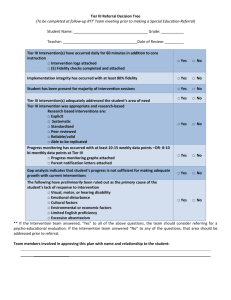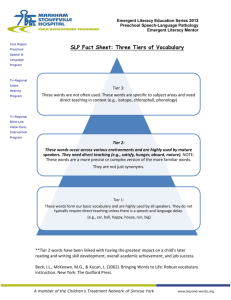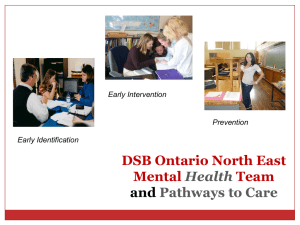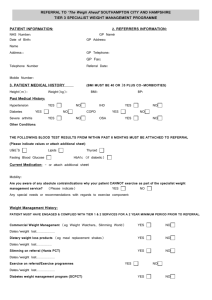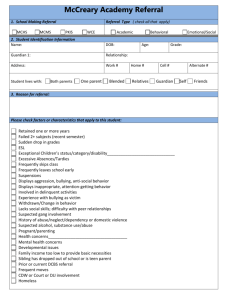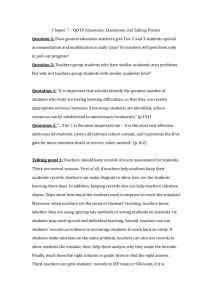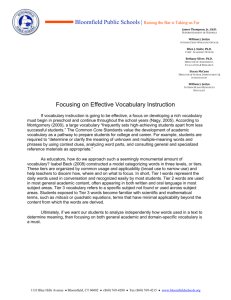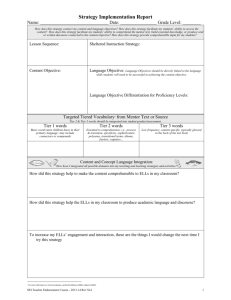School and Preschool Health Services
advertisement
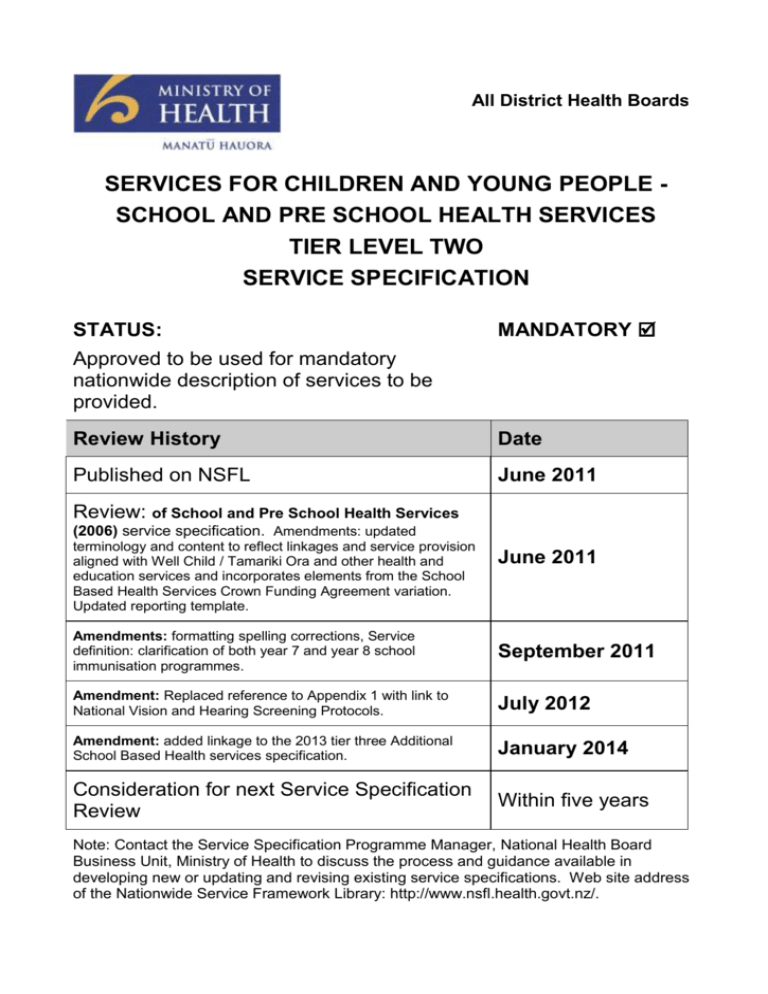
All District Health Boardss SERVICES FOR CHILDREN AND YOUNG PEOPLE SCHOOL AND PRE SCHOOL HEALTH SERVICES TIER LEVEL TWO SERVICE SPECIFICATION STATUS: MANDATORY Approved to be used for mandatory nationwide description of services to be provided. Review History Date Published on NSFL June 2011 Review: of School and Pre School Health Services (2006) service specification. Amendments: updated terminology and content to reflect linkages and service provision aligned with Well Child / Tamariki Ora and other health and education services and incorporates elements from the School Based Health Services Crown Funding Agreement variation. Updated reporting template. June 2011 Amendments: formatting spelling corrections, Service definition: clarification of both year 7 and year 8 school immunisation programmes. September 2011 Amendment: Replaced reference to Appendix 1 with link to National Vision and Hearing Screening Protocols. July 2012 Amendment: added linkage to the 2013 tier three Additional School Based Health services specification. January 2014 Consideration for next Service Specification Review Within five years Note: Contact the Service Specification Programme Manager, National Health Board Business Unit, Ministry of Health to discuss the process and guidance available in developing new or updating and revising existing service specifications. Web site address of the Nationwide Service Framework Library: http://www.nsfl.health.govt.nz/. SERVICES FOR CHILDREN AND YOUNG PEOPLE – SCHOOL AND PRE SCHOOL HEALTH SERVICES TIER LEVEL TWO SERVICE SPECIFICATION COCH0027 This tier two service specification for School and Pre School Health Services (the Service) must be used in conjunction with the tier one Services for Children and Young People service specification. It is also linked to the tier two Well Child / Tamariki Ora Services (WCTO), tier two Outreach Immunisation Services and the tier three Before School Checks (B4SC) and Additional School Based Health Services service specifications. This service specification must be read in conjunction with following documents: the Well Child / Tamariki Ora National Schedule, Child Health Strategy (1998) Improving the Health of Young People – guidelines for school-based health care (Ministry of Health 2004). 1. Service Definition School and Pre School Health Services are those services and programmes that are delivered to children and young people (the Service users) in schools and early childhood centres (the Facilities) and occasionally in other community settings including homes of children and young people. In principle, the focus of the Service will be on the identified needs of children and young people. It is expected that the level of intensity of Service provision will be higher to those Facilities with the lowest decile rating. The Service fits within the framework of the Child Health Strategy and is complementary to any service provided by other health providers or by the education and welfare sectors. The Service will ensure that access to primary health care is appropriate and that timely referrals are made in order to improve the health of children and young people and reduce inequalities. The Service will help to link the Service users with lead primary health care service providers to improve their access to appropriate services eg, mental health services, drug and alcohol services, nutrition, weight and exercise services, and positive youth development programmes. The Service delivery to children attending early childhood centres complements other WCTO services available to children aged less than 5 years. As there are significant WCTO services available to these children provided by Plunket, and Māori and Pacific health service providers, children identified as not enrolled with the relevant WCTO service will be referred onto these providers and Primary Health Organisations (PHOs). The Service supports a range of services to be provided that include all or most of the following components: National Vision and Hearing Screening Protocols - refer http://www.health.govt.nz/publication/national-vision-and-hearing-screening-protocols assessment and referral services - new entrant assessment (if indicated) case management services Services for Children and Young People - School and Pre School Health Services tier two service specification January 2014 Nationwide Service Framework 2 year 7 and year 8 school immunisation programmes, and any special immunisation programmes as required by the local Medical Officer of Health or the Ministry of Health opportunistic immunisation by accredited vaccinators eg, BCG1 vaccination to ‘at risk’ neonates involvement in Strengthening Families2 programmes mobile ear caravan services (where currently provided) adolescent clinics and self-referral clinics (where currently provided) communicable disease prevention or control in association with Public Health Services. 2. Service Objectives 2.1 General The primary objective of the Service is to enable Service users to access to a health service associated with their place of learning. The focus of the Service is on improving outcomes for Service users and to reduce inequalities. It is recognised that some children and young people require considerably more input to be provided by the Service in order for them to achieve the same outcomes. These children and young people may be: tamariki and rangatahi Māori Pacific children and young people refugee and new migrant children socially and economically disadvantaged children with high health and disability support needs. It is expected that access to the Service will support and assist the Service users to maximise their physical, mental and emotional health potential, thereby establishing a strong foundation for ongoing healthy development. This will be achieved by: 1 improving the Service users access to health assessments and referrals, by: - providing the opportunity to access a Registered Nurse - supporting early detection and treatment of problems related to vision, hearing, behaviour and development, and other health and disability conditions, to support their learning, performance and positive development - providing timely referrals to appropriate services with active follow up on these referrals developing and providing children and youth friendly services and recognising the competence of young people to make decisions and to give consent for treatments and services Bacille Calmette-Guérin, (BCG) is a vaccine against tuberculosis. The Strengthening Families strategy is an intersectoral initiative led by the Ministries of Health and Education and the Department of Social Welfare in consultation with other key government and community agencies. Strengthening Families aims to improve the wellbeing of families and achieve better outcomes for children. Services for Children and Young People - School and Pre School Health Services tier two service 3 specification January 2014 Nationwide Service Framework 2 assisting pregnant young women to continue attending the Facility and encouraging re-enrolment after their pregnancy. The Service will also assist those Service users who are young fathers and mothers to acquire parenting skills working with staff in the Facilities and with other health service providers such as WCTO providers, PHOs / General Practitioners and practice nurses to ensure that Service users receive the health care they need if not already enrolled, assisting Service users and their parents or guardians to enrol them in PHOs working with families and whānau, communities and other agencies by: - supporting the families and whānau of the Service users to maximise their young person’s developmental and health status - supporting other Ministry and DHB programmes and services in the Facilities including those provided by public health nurses - supporting collaboration between the health and education sectors. The establishment of the Service will involve a process of consultation with the Service users, staff and the Facilities governance, parents / guardians and the community - where appropriate, working with and sharing information with relevant local and regional services. 2.2 Māori Health An estimated 35 percent of children aged 0-14 years live in NZDep2006 decile 10 (the most deprived decile) of which 72.4% are Māori. The causes of unequal health outcomes are complex and generally linked to the uneven distribution of the determinants of health, such as income, housing, education and employment. For example, low income or poverty is a key mediator of poor child health outcomes. It often leads to poor quality accommodation with consequent overcrowding, and susceptibility to infectious diseases. Poverty also leads to poorer access to healthcare. In addition refer to the tier one Services for Children and Young People service specification. 3 Service Users The Service is to be available to all children and young people up to the age of 18 years of age who are enrolled in schools and early childhood centres within a defined DHB catchment.3 It is expected that a major focus of the service will be around the four priority populations identified in the 1998 Child Health Strategy. The Service users include: tamariki Māori and youth Pacific peoples children and youth children and youth with high health and disability support needs children and youth from families with multiple social and economic disadvantages. 3 Also refer to the Health and Disability Services eligibility direction 2011 sections B17 and B18. Services for Children and Young People - School and Pre School Health Services tier two service specification January 2014 Nationwide Service Framework 4 4. Access 4.1 Entry and Exit Criteria All Service users access the Service either by self-referral or by referral from a Facility, parent / guardian / caregiver or other health service provider as well as from other sectors. All Service users will be able to access the vision hearing programme and immunisation events. 4.2 Distance The Service will be delivered in the Facility or, if appropriate in the student’s home or community. If the Service is provided in the Facility it will be able to be accessed by the users of the Service as close as possible to where they live within the bounds of quality and safety. 4.3 Time The Service will be available between the hours of 8.00 am and 5.00pm from Monday to Friday except for Public holidays. The Service will remain operational during Facility holidays but is not expected to provide services in the Facilities, although some early education centres may remain open. In the case of a communicable disease outbreak or other emergency the Service may need to work outside the usual operating hours. In the event of any significant changes to the immunisation schedule the Service will be required to deliver a ‘catch up‘ programme in the Facility by an accredited vaccinator.. 5. Service Components 5.1 Processes 5.1.1 Pre-School Facility / Programme Children attending early childhood centres who are: not receiving WCTO care from another service provider will be referred to a WCTO service provider for ongoing care not enrolled with PHOs will be assisted in enrolling with a PHO not fully immunised will be vaccinated by a an accredited vaccinator. The Service will provide: health education and information onward referral of individual children to WCTO service providers and general practice vision hearing screening follow-up communicable disease prevention or control in association with Public Health regular visiting programme or other method of interaction. (Minimum level of service is twice a year) opportunistic immunisation services. 5.1.2 School Facility / Programme The Service will provide: health education and information Services for Children and Young People - School and Pre School Health Services tier two service specification January 2014 Nationwide Service Framework 5 case management of children. (Usually this will be for those children in the priority groups described in Section 4.1 and for those children who have no other identified health provider.) vision hearing screening follow-up referral to health providers including Health Camps and other sectors as appropriate regular visiting programme (minimum level of service is twice a term) a school based immunisation programme. 5.2 Pacific Health Service will deliver on the Ministry’s Pacific Health strategies. Refer to the tier one Services for Children and Young People and tier two Well Child / Tamariki Ora service specifications 5.3 Settings The Service will be provided in the Facility, the child’s home, other community setting or a hospital community facility. 5.4 Equipment You will provide all the resources, and equipment necessary to deliver an effective service. 5.5 Support Services Availability of professional advice from other services delivered by the Service, eg. Medical Officer of Health, Public Health, Dental Health Programme, Child and Mental Health Services, Paediatric Services, Child Development Services, Maori Health Services, and Services for Pacific People. 5.6 Key Inputs The Service must recognise the importance of an integrated continuum of care as well as an effective population health focus to ensure efficient use of professional resources. The Service is multidisciplinary with input from: Nurse Practitioners (where available) Public Health Nurses Hearing Vision Technicians Other health professionals Community Health Workers (Māori, Pacific, and refugee where appropriate) Specialist Ear Resource Nurses (if providing a Mobile Ear Service) Accredited Vaccinators Supply of safely stored vaccines. Empathy and expertise are two vital qualities for staff working with children and young people. The Service will ensure that all persons delivering the Service are empathetic to children and young people and are competent to practice with this group. Where relevant, they must be currently registered with or licensed by the appropriate statutory or professional body. Services for Children and Young People - School and Pre School Health Services tier two service specification January 2014 Nationwide Service Framework 6 6. Service Linkages Generic service linkages are described in the tier one Services for Children and Young People service specification. The Service linkages include, but are not limited to the following: Service Provider Nature of Linkage Accountabilities associated with linkages PHO / General Practice Team (GPT) Refer or liaise re individual children as appropriate Clinical consultation and collaboration. Work with other relevant professionals whenever there are concerns relating to a particular Service user. Child, Youth & Family (CYF) Liaise and work with CYF. Participate in Family Group Conferences as required To ensure continuity and quality of care for the child and their family and whānau. Refer to CYF where a child’s safety is at risk from abuse or neglect Work with other relevant professionals in CYF whenever there are concerns relating to a particular Service user referred or under CYF supervision. WCTO and B4SC services Liaise and refer To ensure timely intervention occurs and continuity of care is provided where child in Early Childhood Centre is identified as needing to meet WCTO Schedule requirements Outreach Immunisation Services Liaise and refer To ensure timely intervention occurs and continuity of care is provided where child in Early Childhood Centre is identified as needing to meet the current Immunisation Schedule Interagency Co-ordination (Strengthening Families) Attend or instigate Interagency Co-ordination meetings as appropriate To ensure continuity and quality of care for the client Lead Maternity Carers (LMCs) Liaise and work with a service user’s LMC To provide education, information or expert opinion for Services users who are pregnant Health Communities Attend or instigate Interagency Co-ordination meetings as appropriate To ensure timely intervention occurs and provide continuity of care for the User Education Services – Special Education, Social Workers in Schools, Resource Teacher: Learning and Behaviour services (RTLBs) Liaise and refer where Services User is identified as needing service To ensure timely intervention occurs and provide continuity of care for the Service user Schools and Preschools Refer or liaise re Service users as appropriate To ensure timely intervention occurs and provide continuity of care for the Service user Services for Children and Young People - School and Pre School Health Services tier two service specification January 2014 Nationwide Service Framework 7 Service Provider Nature of Linkage Accountabilities associated with linkages Children’s Health Camps Refer or liaise re Service users as appropriate To ensure timely intervention occurs and provide continuity of care for the Service user Hospital Specialist Services and Community Health Services Refer to relevant Hospital service when a child’s health or development are of concern Liaise and work with relevant professional whenever there are concerns relating to the health or development of a particular child To ensure timely intervention occurs and provide continuity of care Work with other relevant professionals whenever there are concerns relating to a particular child/young person Vision Hearing Screening Services Refer or liaise re individual Service users To ensure timely intervention occurs and provide continuity of care for the User Whakarongo Mai Ear Health Service Refer or liaise re individual Service users To ensure timely intervention occurs and provide continuity of care for the User Dental Services Refer or liaise re individual Service users To ensure timely intervention occurs and provide continuity of care for the User Community Agencies Refer or liaise re individual Service users To ensure timely intervention occurs and provide continuity of care for the User Refugee services Facilitate Service access and participation Liaise with communities to ensure appropriateness and accessibility to services. 7. Exclusions This service specification does not include services described in other service specifications such as Infant, Child and Adolescent Mental Health Services and Children and Young People in care of Child and Youth and Family Residences. 8. Quality Requirements 8.1 General The Service must comply with the Provider Quality Standards described in the Operational Policy Framework or, as applicable, Crown Funding Agreement Variations, contracts or service level agreements. 8.2 Acceptability You must comply with the: current Well Child Tamariki Ora National Schedule Handbook – available on the Ministry of Health’s website http://www.moh.govt.nz/moh.nsf/indexmh/nationalschedule-handbook Services for Children and Young People - School and Pre School Health Services tier two service specification January 2014 Nationwide Service Framework 8 New Zealand Disability Strategy Family Violence Intervention Guidelines available on the Ministry of Health’s website http://www.moh.govt.nz/moh.nsf/indexmh/family-violence-guidelines-child-partnerabuse 8.3 Safety and Efficiency You will ensure staff: have training in how to identify, support and refer victims of interpersonal violence with a particular focus on child and partner abuse. The Service provider must have protocols in place to support staff in this intervention. training is given, specifically in disability awareness to ensure disabled children and disabled carers are given appropriate access and support. 8.1 Acceptability The Service must ensure that delivery is provided in a way that recognises the cultural and social difference between the Facilities and the different needs of the Users, their parents and caregivers. Planning and development of the Service must take account of tamariki Māori and their families’ needs, as well as the needs of Pacific children. 9. Purchase Units and Reporting Requirements 9.1 Purchase Units are defined in the joint DHB and Ministry’s Nationwide Service Framework Data Dictionary. The following Purchase Unit applies to this Service. PU Code PU Description PU Definition PU Measure PU Measure Definition National Collections and Payment Systems COCH0027 School and preschool health based services School and pre school based health services for children up to 18 years of age enrolled in preschools and schools. Client Number of clients managed by the service in the reporting period ie. caseload at the beginning of the period plus all new cases in the period. National Nonadmitted Patient Collection (NNPAC) and Contract Management System (CMS) (as per contract) The Service must comply with the requirements of national data collections. 9.2 Reporting Requirements PU Code Frequency COCH0027 Monthly Reporting requirements Total number of clients Quarterly Total number of clients Number of Clients by ethnicity (NZ Maori) Number of Clients by ethnicity (Pacific Island) Number of Clients by ethnicity (Other) Total number of client contacts The average number of contacts received per client The least number of contacts received by a client Services for Children and Young People - School and Pre School Health Services tier two service specification January 2014 Nationwide Service Framework 9 PU Code Frequency Reporting requirements COCH0027 Quarterly The most number of contacts received by a client Total number of new clients Number of new clients by referral source (GP) Number of new clients by referral source (DHB) Number of new clients by referral source (Other) Number of new clients by referral source (Well Child / Tamariki Ora Provider) Number of new clients by referral source (Government Department) Number of new clients by referral source (School) Number of new clients by referral source (Parent / Caregiver) Number of new clients by referral source (Education Services) Number of new clients by referral source (Early Childhood Centre) Total number of clients discharged Number of clients discharged by reason (Other) Number of clients discharged by reason (Child moved out of the area) Number of clients discharged by reason (Family /whanau have made informed choice not to use service) Number of clients discharged by reason (Number of clients who no longer need the service) Annually Total Number of active cases at end of calendar year Total Number of clients immunised by end of calendar year Number of clients immunised by end of calendar year (NZ Maori) Number of clients immunised by end of calendar year (Pacific Island) Number of clients immunised by end of calendar year (Other) Number of clients discharged by reason (Number of clients who no longer need the service) 9.3 The Register The Provider will establish and maintain a register of all Service users accepted into their service. This register will record the following Service user’s information: family and first name NHI number date of birth ethnicity* address and telephone number parent/guardian/caregiver’s name and address next-of-kin’s name and address general practitioner’s name and address date of each contact date of referral to service date of exit from service Services for Children and Young People - School and Pre School Health Services tier two service specification January 2014 Nationwide Service Framework 10
